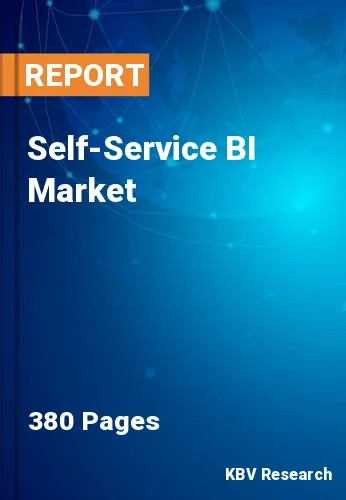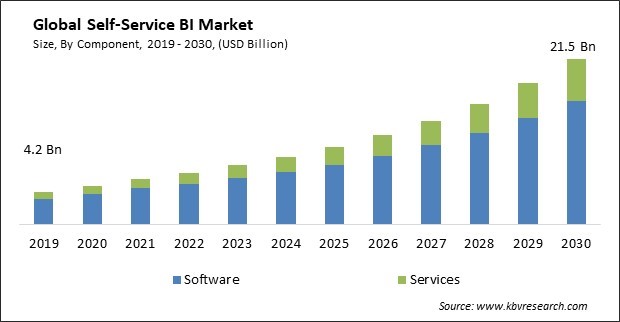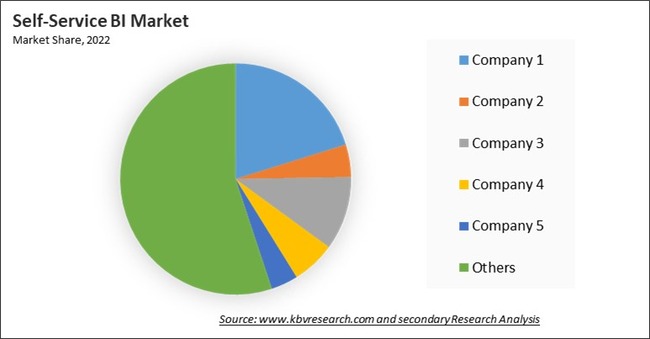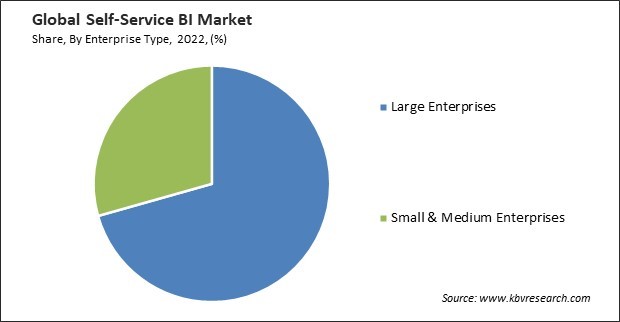
The Global Self-Service BI Market size is expected to reach $21.5 billion by 2030, rising at a market growth of 15.8% CAGR during the forecast period.
The healthcare and life sciences segment garnered a promising growth rate in the self-service BI market in 2022. Healthcare associations deal with vast amounts of data, from patient records to clinical and financial information. Consequently, the healthcare and life sciences segment generated $791.2 million revenue of the market in 2022. Self-service BI tools empower healthcare professionals to extract actionable insights from this data. Healthcare providers use self-service BI to analyze clinical data, such as electronic health records (EHRs), lab results, and patient histories. This aids in diagnosing and treating patients more effectively. Some of the factors affecting the market are ease of use for non-technical staff, expanding volume of business data, and data protection law and inaccuracy in data.

The ease of use for non-technical staff has been a significant driver of growth in the self-service BI market. Self-service BI tools are designed to empower individuals needing a background in data analytics or IT to access, analyze, and visualize data. These tools break down traditional barriers to data access and analysis. They allow business users across departments to finance their operations independently, working with data without relying on IT or data analysts. Non-technical staff can create reports, dashboards, and visualizations without IT intervention. This eases the burden on IT departments and allows them to concentrate on more strategic tasks. Moreover, In the digital era, businesses generate and collect vast amounts of data from various sources, including sales transactions, customer interactions, website activity, social media, sensors, and more. This abundance of data presents both opportunities and challenges. Businesses now deal with diverse data sources, such as structured data (e.g., databases), semi-structured data (e.g., log files), and unstructured data (e.g., text and multimedia). Self-service BI tools are equipped to handle this variety of data, making them indispensable for data analysis. Therefore, the increasing importance of business data is a driving force behind the growth of the market.
However, Self-service BI often involves accessing and analyzing sensitive and personal data. Organizations are required by stringent privacy laws, like the California Consumer Privacy Act (CCPA) in the US or the General Data Protection Regulation (GDPR) in Europe, to ensure the security and confidentiality of such information. This can create compliance challenges for self-service BI implementations, as ensuring data security and privacy becomes paramount. Data protection laws often require organizations to obtain explicit consent from individuals to collect and process their data. Managing user permissions and consent within self-service BI platforms can be complex. Inaccuracies in data can introduce bias into analytical results, leading to unfair or discriminatory outcomes. Detecting and addressing bias in self-service BI is a critical concern. Due to such factors, the market growth will decline.

The leading players in the market are competing with diverse innovative offerings to remain competitive in the market. The above illustration shows the percentage of revenue shared by some of the leading companies in the market. The leading players of the market are adopting various strategies in order to cater demand coming from the different industries. The key developmental strategies in the market are Acquisitions, and Partnerships & Collaborations.
On the basis of deployment, the market is fragmented into on-premises and cloud. The cloud segment garnered a significant revenue share in the market in 2022. Cloud deployment in the self-service BI market refers to the hosting and delivering BI software and tools over the internet through cloud computing infrastructure. Cloud-based self-service BI solutions have become increasingly popular due to their scalability, flexibility, cost-effectiveness, and accessibility. Cloud deployments often require lower upfront capital expenditures than on-premises solutions because organizations do not need to invest in their infrastructure and hardware. Instead, they pay for cloud services on a subscription or usage-based model.
By enterprise type, the market is classified into large enterprises and small & medium enterprises. In 2022, the large enterprise segment generated the highest revenue share in the market. Large enterprises often have diverse employees across various departments and roles. Self-service BI tools allow non-technical staff, such as marketing managers, financial analysts, and sales representatives, to independently access and analyze data, reducing their reliance on IT or data experts. Large enterprises are increasingly adopting self-service BI due to its ability to empower business users, improve decision-making, and streamline data analysis processes. Large enterprises deal with vast volumes of data, and timely decision-making is crucial.

Based on application, the market is categorized into sales & marketing, customer engagement & analysis, fraud & security management, risk & compliance management, predictive asset maintenance, operations management, supply chain management & procurement, and others. The supply chain management & procurement segment projected a considerable revenue share in the market in 2022. Self-service BI tools offer valuable supply chain management and procurement applications, helping organizations optimize their supply chain operations, reduce costs, and make data-driven decisions. Self-service BI applications in supply chain management and procurement empower organizations to leverage data for better decision-making, optimize supply chain operations, and enhance supplier relationships.
On the basis of vertical, the market is segmented into BFSI, retail & ecommerce, telecom & IT, healthcare & life sciences, manufacturing, transportation, energy & utilities, and others. The telecom & IT segment procured a significant revenue share in the market in 2022. Telecom companies use self-service BI to monitor the performance of their networks, including latency, bandwidth usage, and network congestion. The telecom and IT industry continually introduces new products and services. Self-service BI assists in analyzing the performance of these offerings and optimizing product portfolios. Telecom and IT companies analyze network traffic and resource utilization data to plan for network expansion, optimize resource allocation, and meet growing demand.
Based on component, the market is segmented into software and services. In 2022, the software segment dominated the market with the maximum revenue share. Self-service BI software democratizes data access and analysis, making it a valuable asset for organizations aiming to harness the full potential of their data while empowering users to make data-driven decisions efficiently. Self-service BI software provides easy access to data from various sources, including databases, spreadsheets, and cloud applications. Users can combine data from multiple sources for comprehensive analysis. The software often includes data cleansing and transformation capabilities, helping users maintain data quality and consistency across reports and analyses.
| Report Attribute | Details |
|---|---|
| Market size value in 2022 | USD 6.7 Billion |
| Market size forecast in 2030 | USD 21.5 Billion |
| Base Year | 2022 |
| Historical Period | 2019 to 2021 |
| Forecast Period | 2023 to 2030 |
| Revenue Growth Rate | CAGR of 15.8% from 2023 to 2030 |
| Number of Pages | 383 |
| Number of Table | 590 |
| Report coverage | Market Trends, Revenue Estimation and Forecast, Segmentation Analysis, Regional and Country Breakdown, Market Share Analysis, Companies Strategic Developments, Company Profiling |
| Segments covered | Component, Deployment, Enterprise Type, Application, Vertical, Region |
| Country scope | US, Canada, Mexico, Germany, UK, France, Russia, Spain, Italy, China, Japan, India, South Korea, Singapore, Malaysia, Brazil, Argentina, UAE, Saudi Arabia, South Africa, Nigeria |
| Growth Drivers |
|
| Restraints |
|
Region-wise, the market is analyzed across North America, Europe, Asia Pacific, and LAMEA. In 2022, the Asia Pacific region generated a considerable revenue share in the market. The Asia-Pacific region is expected to be one of the fastest-growing regions in the support market because of the expanding adoption of the Internet of Things (IoT) and innovative technologies and other government initiatives, such as developing smart cities in China and India. The APAC region is experiencing digital transformation across sectors. Companies are investing in digital infrastructure, e-commerce platforms, and online services, resulting in a wealth of digital data that can be analyzed using self-service BI. The adoption of cloud-based self-service BI solutions is rising in APAC, as they offer scalability, flexibility, and accessibility without significant infrastructure investments.
Free Valuable Insights: Global Self-Service BI Market size to reach USD 21.5 Billion by 2030
The market research report covers the analysis of key stakeholders of the market. Key companies profiled in the report include Microsoft Corporation Oracle Corporation, IBM Corporation, SAP SE, ThoughtSpot, Inc., Zoho Corporation Pvt. Ltd., Domo, Inc., QlikTech International AB, MicroStrategy, Inc., Salesforce, Inc. (Tableau Software, LLC).
By Component
By Deployment
By Enterprise Type
By Application
By Vertical
By Geography
This Market size is expected to reach $21.5 billion by 2030.
Ease of use for non-technical staff are driving the Market in coming years, however, Data Protection law and inaccuracy in data restraints the growth of the Market.
Microsoft Corporation Oracle Corporation, IBM Corporation, SAP SE, ThoughtSpot, Inc., Zoho Corporation Pvt. Ltd., Domo, Inc., QlikTech International AB, MicroStrategy, Inc., Salesforce, Inc. (Tableau Software, LLC).
The expected CAGR of this Market is 15.8% from 2023 to 2030.
The On-Premise segment is leading the Market by Deployment in 2022; thereby, achieving a market value of $10.6 billion by 2030.
The North America region dominated the Market by Region in 2022 and would continue to be a dominant market till 2030; thereby, achieving a market value of $7.3 billion by 2030.
Our team of dedicated experts can provide you with attractive expansion opportunities for your business.
